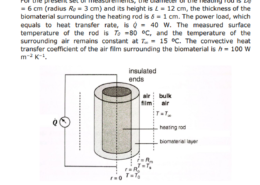Share
The device shown in Figure 3 is used to estimate the thermal conductivity of a new biomaterial by measuring the steady-state heat transfer rate and temperature. The biomaterial is wrapped around the cylindrical heating rod. The exposed ends of the device are sealed and insulated. A constant electrical power load is passed through the heating rod and dissipated as heat through the biomaterial layer and then through the surrounding air film layer to the bulk air. The temperature of the heating rod’s cylindrical surface is constant and equals to T0 (T = T0). For the present set of measurements, the diameter of the heating rod is D0 = 6 cm (radius R0 = 3 cm) and its height is L = 12 cm, the thickness of the biomaterial surrounding the heating rod is δ = 1 cm. The power load, which equals to heat transfer rate, is 𝑄̇ = 40 W. The measured surface temperature of the rod is T0 =80 ºC, and the temperature of the surrounding air remains constant at 𝑇∞ = 15 ºC. The convective heat transfer coefficient of the air film surrounding the biomaterial is h = 100 W m−2 K−1
ReportQuestion

Answer ( 1 )
Please briefly explain why you feel this answer should be reported.